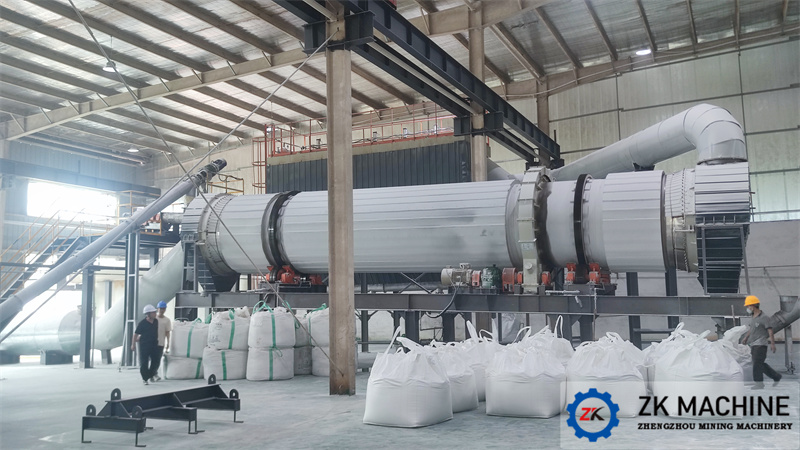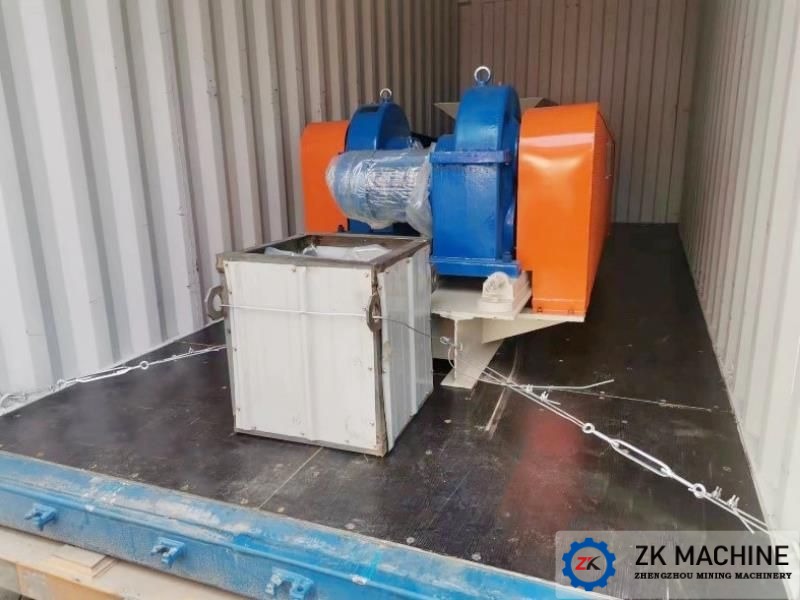Several Common Problems and Troubleshooting in Lime Kiln Raw Firing
Several common problems and troubleshooting such as raw burning in lime kiln.
1. The particle size is too large
The rate at which limestone is calcined depends on the amount of lime and the temperature of contact with the surface of the limestone. But at a certain temperature, the calcination speed of limestone depends on the particle size of the limestone. The greater the material content, the slower the calcination speed. Here, since the thermal conductivity of lime is smaller than the progress of lime calcination, the thickness of the lime layer gradually increases, the harder it is for heat to enter the interior of the stone, and the calcination speed is also slower. Therefore, large pieces of limestone are often sandwiched, and burnt lime is the first reason for this. The particle size of ordinary vertical kilns should be controlled at 40-80mm. For large kilns, the particle size can be relaxed to 50-150mm. In order to save the cost of limestone, small stones can also be used exclusively.
2. The fuel proportion is small or the fuel calorific value is low
The proportion of fuel used in a mixed-fired kiln is related to the technical performance of the kiln. The coal used in a mixed-fired kiln generally requires a calorific value of more than 5,500 kcal. The particle size must be controlled to a certain extent, and water must be added appropriately when using coal powder.
3. Unreasonable air supply
The stone in the lime kiln is heated and calcined by the combustion of fuel, and the fuel is burned by oxygen (air). The combustion of any fuel must meet three conditions including fuel, oxygen, and fire. Each one is indispensable, and it requires strong wind and fire. , uniform wind and uniform fire. In addition to a certain proportion of fuel, it is the rationality of the air supply. On the cross section of the kiln, some local air volumes are large and some are small. After the place with strong wind is burned, the place with small wind will naturally burn. Burning occurs. The air supply needs to be reasonable so that the air can be blown evenly across the entire kiln section so that the fuel can be burned evenly.
4. Overheating
The quality of quicklime depends first on the content of calcium oxide and magnesium oxide, and secondly on the overburning rate of quicklime. Underburning means that part of the limestone has not been completely decomposed, and overburning means that the limestone has been excessively calcined. Quicklime is dense, also called burnt lime or burnt lime. This part of quicklime has low activity and is difficult to differentiate in subsequent production. The normal combustion temperature of ordinary limestone is 1000-1200°C. Overburned ash usually results in excessively high combustion temperature and long time, and cracks or glassy shells appear on the surface. The volume The shrinkage is obvious, the color is burned to black, and the volume of the block increases. To deal with over-burning, the first step is to consider whether the fuel ratio is too large. It should be adjusted to a reasonable ratio. The coal quantity should fully consider the quality of the coal. At the same time, the air supply should also be adjusted to adapt to several operational problems.
4.1 Moving the calcining zone upward
In the calcining zone of an ordinary vertical kiln, if the top temperature rises in the middle of the kiln body, the ash temperature decreases, the CO2 content decreases accordingly, the air volume is large, and excess oxygen increases, this means that the calcining belt has moved. After the calcining belt moves, the fuel will The upper part of the kiln burns early. When the charge falls to the calcining zone, the fuel has no firepower, and the amount of lime burned will naturally increase. The top temperature control is too high or the fuel entering the kiln is fragmented and burns prematurely. The wind pressure and air volume are too large, or the limestone particle size is too large, the ventilation is smooth, and the ash discharge amount is unbalanced, which are also the reasons for the upward movement of the calcining area. Formed raw and burned.
When encountering this situation you should:
(1) Reduce the wind pressure and air volume to move the fire layer downward. If the top pressure is low, you can increase the top pressure appropriately.
(2) Increase the ash discharge volume and appropriately increase the fuel ratio to supplement the heat loss caused by the high top temperature when it has not returned to normal, and adjust it to the normal value after normalization.
(3) Check and adjust the raw and fuel particle size. If the fuel powder content is too high, water can be added to saturate it to increase its adhesion with the stone to delay the fuel burning time.
4.2 Calcination zone moves downward
When it is found that the top temperature is low, the gray temperature rises, and in severe cases, the wind and fire fail to burn out the fuel. The burning of lime also increases, and at the same time the CO2 concentration decreases, which means that the calcination zone moves downward. The main reason for this situation is that the air volume is small, the amount of stone loaded, and the amount of ash discharged are large, which makes the mixture move downward quickly, and the cooling zone is shortened. The air enters the calcining zone before it is sufficiently preheated, causing the calcium carbonate to decompose. Reduced, CO2 also decreased accordingly. Resulting in an increase in the amount of lime burned. In addition, if the raw materials are fragmented or the particle size deviation is large, the resistance in the kiln increases. At this time, the air pressure is not low, but the actual air volume is not enough.
When encountering this situation you should:
Appropriately reduce the amount of stone loading and ash unloading, appropriately increase the air volume, if the top pressure is too large, you can appropriately reduce the material batch, change the partial crushing of raw materials, appropriately increase the proportion of large particles, reduce the particle size difference, and reduce the resistance in the kiln. Small. Adjust the fuel and stone mass to meet the process requirements.
4.3 Extension of the calcining zone
The extension of the calcining zone will cause the top temperature and ash temperature to be high, CO2 will decrease, and the amount of lime burning will also increase. In severe cases, red ash will appear on the top of the kiln and under the fire, that is, red will appear at both ends. Nodules are formed in the kiln or local ventilation is poor. The reason is that the fuel ratio is too large and the uniformity of the limestone is poor. Nodules are formed in the kiln or local ventilation is poor. At the same time, there are nodules or materials hanging on the kiln wall, and ventilation segregation occurs. The nodules or hanging materials prevent the material from falling normally and the ventilation is poor. Since the lumps fall off under the impact of material flow, the calcining zone will also be extended for a certain period of time.
In this case you should:
Appropriately reduce production, adjust raw material particle size, reduce fuel ratio and increase air volume appropriately. Temporarily lower the height of the material layer and then return the material to the normal material level.
4.4 Nodulation
Nodulation is a major fault in mixed-fired kilns, including gas-fired kilns. At this time, you can find:
(1) The ash temperature remains high at all times, raw burning occurs at the same time as the lime is unloaded, and the CO2 content of the kiln gas remains low for a long time;
(2) The height of the material surface does not match the amount of ash discharged. The residence time of the material in the kiln is shortened, but the ash discharge time is extended. The ash is mixed with unburned fuel and uncalcined limestone to form green ash. The main reasons are:
(1) The fuel ratio is too high, or there are too many impurities in the fuel, resulting in fusible matter.
(2) Although the ratio is not high, the fuel is locally concentrated and the calcination is intense to form kiln wall hanging materials.
(3) Nodules are likely to form when there is a power outage or long-term inability to produce normally. The high-temperature zone stays in the kiln for an extended period of time or impurities are present.
When encountering this situation you should:
(1) Adjust the fuel ratio and wind pressure to reduce the impurity content of the raw fuel.
(2) Reduce the loading amount or increase the ash unloading amount, lower the height of the material surface, expose the lumps or hanging materials, and make them fall off after cooling and loading impact. In severe cases, small blasting measures may be taken.
(3) Change the uneven mixing and distribution of raw fuel to avoid excessive local fuel.
(4) Increase the frequency of loading and unloading to increase the flow of materials and avoid sticking.
4.5 Partial kiln
When the kiln is in a partial kiln, it can be found from the top of the kiln that the material surface is tilted and the material is discharged quickly on one side. The fire layer on one side is dark, indicating that the temperature difference between the fire layer on the material surface is large. From the bottom of the kiln, it can be seen that ash comes out quickly locally or on one side when unloading ash, and red ash sometimes comes out when the ash temperature is high here. The main reasons are:
(1) The mixture is unevenly distributed or the ash is unevenly discharged, causing local nodules in the kiln, resulting in local ventilation segregation. Solving the fabric in this situation is critical.
(2) Improper adjustment of ash unloading equipment causes unbalanced ash unloading.
(3) The kiln shape structure is unreasonable, and the angle between the cooling section and the ash lowering section is too small, causing partial cornering and poor material discharge.
When encountering this situation you should:
(1) Change the mixing of raw materials and fuel or uneven ash discharge. When it is judged that there are local nodules in the kiln, measures should be taken to deal with them first. In serious cases, modification of the kiln structure may also be considered.
(2) The scraps are mostly distributed in the fast-feeding parts, and large pieces are mostly distributed in the dark-fired parts, which increases wind resistance in the fast-fired parts.
Gas fired kiln FAQs
Except for the above common problems, the gas fired kiln is basically the same as the mixed fired kiln. The key is the adjustment of the combustion flame temperature. Gas burning flames generally need to adjust the ratio of air and gas volume and pressure according to the composition and calorific value of different gases.
A common problem with high-calorific-value gas is overburning, while a common problem with low-calorific-value gas is raw burning. However, specific analysis must be done when burning and overburning occur. Many raw burns when using high-calorific value gas are caused by overburning. Due to the heat of the gas, When the value is high, the flame will reach a very high temperature as soon as it comes out of the burner, causing sintering around the burner and blocking the deep penetration of the flame. This will inevitably lead to raw burning in the center of the kiln, or in other words, due to improper adjustment of the calcining temperature, the surface of the limestone will first be sintered. There is a layer of hard shell that looks overcooked on the surface but is actually raw on the inside. These problems are directly related to the kiln type and burner used.




